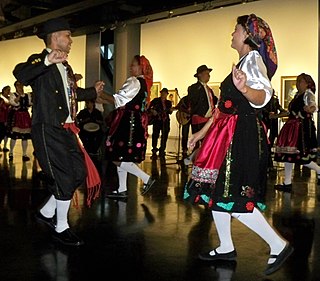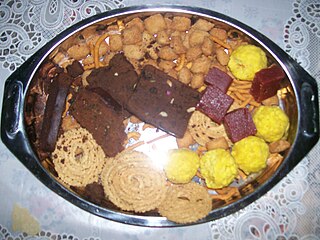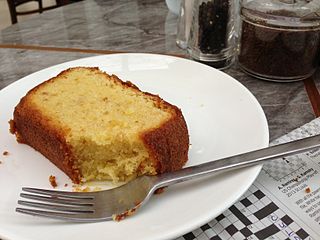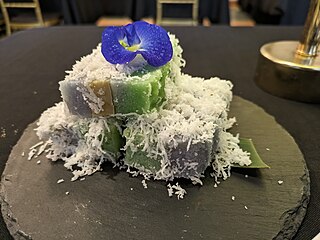
Marzipan is a confection consisting primarily of sugar and almond meal, sometimes augmented with almond oil or extract.

Shortbread or shortie is a traditional Scottish biscuit usually made from one part white sugar, two parts butter and three to four parts plain wheat flour. Shortbread does not contain any leavening, such as baking powder or baking soda. Shortbread is widely associated with Christmas and Hogmanay festivities in Scotland, and some Scottish brands are exported around the world.

Rice pudding is a dish made from rice mixed with water or milk and commonly other ingredients such as sweeteners, spices, flavourings and sometimes eggs.
Eurasian Singaporeans is a term that refers to Singaporeans of mixed European–Asian descent.
Devil curry also known as curry Debal in Kristang is a very spicy curry flavoured with candlenuts, galangal, mustard seed and vinegar from the Eurasian Kristang (Cristão) culinary tradition in Malacca, Malaysia, Indonesia and the Indo-Dutch diaspora. It was historically served one or two days after Christmas and on other special occasions.

Simnel cake is a fruitcake associated with Lent and Easter and widely eaten in England, Ireland and countries with patterns of migration from them. It is distinguished by layers of almond paste or marzipan, typically one in the middle and one on top, and a set of eleven balls made of the same paste. It was originally made for the fourth Sunday in Lent, also known as Laetare Sunday, the Refreshment Sunday of Lent, Mothering Sunday, the Sunday of the Five Loaves, or Simnel Sunday; named after the cake. In the United Kingdom, it is now commonly associated with Mothering Sunday and Easter Sunday.

The Kristang are a creole and indigenous ethnic group of people of primarily Portuguese and Malay descent, with substantial Dutch, British, Jewish, Chinese and Indian ancestry. They are based mostly in Malaysia, Singapore and Australia, the last being due to significant emigration in the second half of the twentieth century. People of this ethnicity also have, besides Malay and Portuguese, Dutch ancestry due to intermarriages, which is common among the Kristang. In addition, due to persecution by the Portuguese Inquisition in the region, a lot of the Jews of Malacca assimilated into the Kristang community. The creole group arose in Malacca between the 16th and 17th centuries, when the city was a port and base of the Portuguese Empire. Today the Malaysian government classifies them as Portuguese-Eurasians; in Singapore, they are primarily known as Kristang. Today, elements of Kristang culture and identity, especially the Kristang language, which is classified as critically endangered by the UNESCO Red Book of Endangered Languages, are currently undergoing cultural and language revitalisation in both Malaysia and Singapore. The Kabesa or leader of the community worldwide and in Singapore is the Kristang Singaporean science fiction writer and linguist Kevin Martens Wong, while the current Regedor or Headman of the Portuguese Settlement of Malacca, the original, geographical, cultural and spiritual centre of the Malacca Portuguese identity, is Oliver Lopez.

Shake Shack is an American fast casual restaurant chain based in New York City. It started out as a hot dog cart inside Madison Square Park in 2001, and its popularity steadily grew. In 2004, it received a permit to open a permanent kiosk within the park, expanding its menu from New York–style hot dogs to one with hamburgers, hot dogs, fries and its namesake milkshakes.

Spekkoek is a type of Indonesian layer cake. It was developed during colonial times in the Dutch East Indies. The firm-textured cake is an Indo (Dutch-Indonesian) version of the multi-layered rice cakes that are usually seen in Southeast Asian desserts but using some Dutch ingredients like flour and butter. It contains a mix of Indonesian spices, such as cardamom, cinnamon, clove, mace and anise. The cake is made of flour and yolk and is rich in butter or margarine.

Kuswar or Kuswad is a set of festive sweets and snacks made and exchanged by Christians of the Konkan region in the Indian subcontinent for the Christmas season or Christmastide. These goodies are major parts of the cuisines of the Goan Catholic community of Goa in the Konkan region, and the Mangalorean Catholic community of Karnataka. There are as many as 22 different ethnic recipes that form this distinct flavour of Christmas celebration in Goa and Mangalore. Kuswad is also made and exchanged by Karwari Catholics of Carnataca and the Kudali Catholics of Sindhudurg, in the Konkan division of Maharashtra.

Sfouf is a Lebanese almond-semolina cake consumed on birthdays, family reunions, and religious holidays. It is made from semolina flour flavored with turmeric, sugar, sesame paste, aniseed, and pine nuts, and raised with baking powder.

Sponge cake is a light cake made with eggs, flour and sugar, sometimes leavened with baking powder. Some sponge cakes do not contain egg yolks, like angel food cake, but most of them do. Sponge cakes, leavened with beaten eggs, originated during the Renaissance, possibly in Spain. The sponge cake is thought to be one of the first non-yeasted cakes, and the earliest attested sponge cake recipe in English is found in a book by the English poet Gervase Markham, The English Huswife, Containing the Inward and Outward Virtues Which Ought to Be in a Complete Woman (1615). Still, the cake was much more like a cracker: thin and crispy. Sponge cakes became the cake recognised today when bakers started using beaten eggs as a rising agent in the mid-18th century. The Victorian creation of baking powder by English food manufacturer Alfred Bird in 1843 allowed the addition of butter to the traditional sponge recipe, resulting in the creation of the Victoria sponge. Cakes are available in many flavours and have many recipes as well. Sponge cakes have become snack cakes via the Twinkie.

Qurabiya also ghraybe, ghorayeba, ghoriba, ghribia, ghraïba, gurabija, ghriyyaba, or kourabiedes and numerous other spellings and pronunciations, is a shortbread-type biscuit, usually made with ground almonds. Versions are found in most Arab, Balkan and Ottoman cuisines, with various different forms and recipes. They are similar to polvorones from Andalusia.

Parrozzo or panrozzo is a cake from the Abruzzo region of Italy. It is traditionally served as a Christmas dessert, but may also be enjoyed year round.

The Eurasian cuisine of Singapore and Malaysia is a type of fusion cuisine.

Love cake or Bolo di Amor, is a type of semolina cake eaten in Sri Lanka on special occasions. They are often baked for cultural celebrations such as Christmas, birthdays and weddings, served wrapped in gold paper for guests to eat or take home.
Breudher, also known as Brueder or Bloeder, is a traditional Sri Lankan Dutch Burgher buttery yeast cake, baked in a fluted mould. A variation, Bleuda, Kueh Bleuda or Kue Bludder is also found in the Malacca Dutch Eurasian community and in Kochi, a city in the south-west of India.

Putugal, also known as kuih putugal or kuih Portugal, is a Eurasian steamed rice cake or kuih that appears in all the former Portuguese territories of Asia. Putugal is typically made from rice or tapioca flour traditionally colored blue using the butterfly pea flower, stuffed with ripened banana and garnished with grated coconut. Among Eurasians, the dessert is a staple during festive celebrations such as Christmas.















